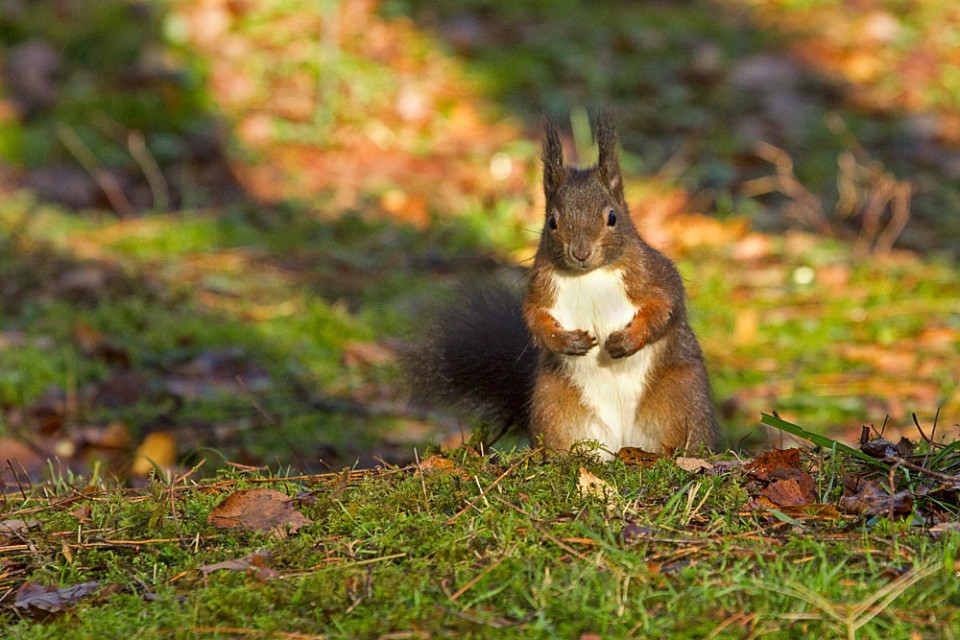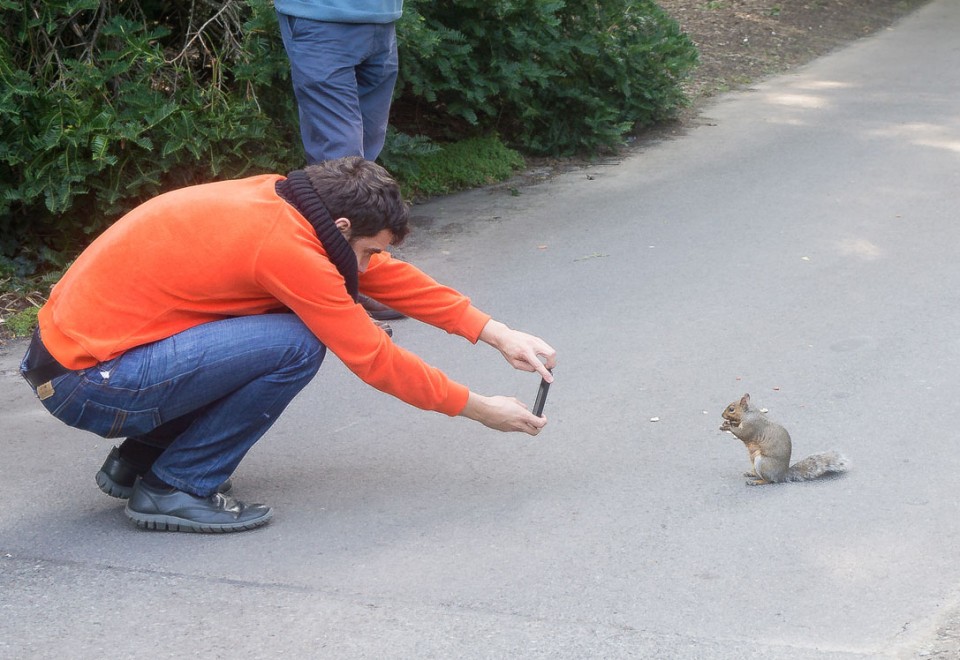The details
The Grey squirrel (Sciurus carolinensis) is native to the oak-hickory woodlands of the eastern United States, where it co-exists with the American red squirrel (Tamiasciurus douglasi) that, despite bearing a striking resemblance to S. vulgaris, is only distantly related to it.
Historically, there have been many introductions of Grey squirrels into parks and forest on the UK mainland. There are records of releases, most from private/pet collections, dating back as far as 1828 when one was apparently released near Denbighshire in north Wales. The first verifiable record is, however, from 1876, when Victorian banker Thomas V. Brocklehurst released a pair of Greys that he brought back from a business trip to America into Henbury Park, near Macclesfield in Cheshire, after their attraction as pets waned. It appears that Mr. Brocklehurst started something of a trend, much like his relative Sir Henry C. Brocklehurst who released red-necked wallabies (Macropus rufogriseus) into Staffordshire during the mid-1930s, and releases continued for the next 50 years. In The Naturalized Animals of Britain and Ireland, Christopher Lever provides a comprehensive account of Grey introductions and noted how:
“Between 1902 and 1929 (the year of the last recorded introduction), a veritable wave of introductions took place in many localities, including Regent’s Park, London; Berkshire; Northamptonshire; Oxfordshire; Staffordshire; Devon; Warwickshire; Nottinghamshire; Suffolk and Hampshire (Bournemouth). From some of these centres, Grey Squirrels spread into Gloucestershire and eastern Wiltshire. The stock for most of the introductions came either directly from the United States or from Woburn.”

In her 1954 book Squirrels, Monica Shorten listed the known releases of Greys and suggested that some of the most significant releases, in terms of helping to establish a wild population, included: Richmond Park in Surrey, where 100 were released in 1902; Regent’s Park in London, where 91 were released between 1905 and 1907; and Woburn Park in Bedfordshire, where ten squirrels imported from New Jersey during the previous year were released during 1890. It should be noted that large releases don’t seem necessary for squirrels to become established and, in a 2010 paper, Colin Lawton and his colleagues looked at the known successful Grey introductions and found just over 70% arose from fewer than 10 animals.
By 1930 Greys were established in the south east, from Kent west to Southampton and north to Warwickshire, and by the mid-1940s they were well distributed throughout the Midlands and most of southern England, excluding Cornwall. By the mid-1950s Greys had spread throughout most of Yorkshire and southern Lancashire and, Lever notes, by the early 1960s it was easier to say where Greys didn’t occur than where they did. Come the mid-1980s they had crossed the Pennines from Yorkshire into Lancashire and Cumbria and had now spread throughout most of Cornwall.
Wales
The first appearance in Wales was at Llandisilio Hall in Denbighshire during October 1828, but it is not known from where these squirrels originated. There is a record of five squirrels from Woburn released at Wrexham in Denbighshire in 1903 and an unknown number from London Zoo released in Aberdare, Glamorganshire during 1922. Overall, Lever implies that the colonisation of Wales, which was largely complete by the mid-1980s, came about through a combination of a few deliberate releases and squirrels colonising from England. Lever recounts Craig Shuttleworth’s experience of Greys on the Isle of Anglesey, where Greys were first spotted in March 1966 on the Bodorgan estate in the south west.

By the late 1990s the Grey population on the island was estimated to be about 3,000 and the Red squirrel survived only in the Pentraeth Forest on the east coast. In 1998 an eradication programme was started and Pentraeth had been cleared of Greys five years later. The Grey population had been reduced to about 100 animals by 2008 and the last Grey was seen in 2013. Consequently, in October 2015, Anglesey was officially declared Grey-free, despite attempts to halt the cull and a petition to stop the 18-year programme gaining about 140,000 signatures. In an article to The Independent newspaper in 2015 it was suggested the Red population on Anglesey was around 700.
Scotland
The first recorded release of Greys into Scotland was in 1892, when a pair were released at Finnart on the shore of Loch Long and several releases followed. Lever During the next 20 years or so Greys spread out in all directions such that, by 1915, they had reached the eastern side of Loch Lomond in Stirlingshire. In The Naturalized Animals of Britain and Ireland, Lever notes how Greys had established themselves over an area of nearly 800 sq-km in Scotland within quarter of a century. Today, Scotland has several established Grey squirrel populations, particularly in the southern half of the country, near Glasgow, Edinburgh and Perth, among other places.
Ireland
In a note to the Irish Naturalist during 1923, Hugh Watt recounted the first known introduction to Ireland: the Earl of Granard releasing “some dozen Grey squirrels from the stock at Woburn, Bedfordshire” at Castle Forbes in County Longford during 1911. Much more recently, genetic analysis by Lisa Signorile and colleagues (2016) and Hannah McLaughlin and her team (2022) suggests that while the number of introductions to Ireland have been substantially reduced compared with the rest of the UK, there may also have been an introduction to County Kildare, as these Greys seems genetically distinct from other Irish populations. Lever notes that by the late 60s and early 70s, Greys were found primarily in northern Leinster and southern Ulster, and by the end of the 70s they reached mid-Ulster. They expanded their range through the midland counties of the Irish Republic during the 80s, soon reaching Wexford and Dublin.

Greys subsequently spread throughout much of the north, east and south of the country and are now found in central and southern Northern Ireland and throughout most of eastern Ireland, with the River Shannon marking the western extent of their range. Perhaps coincidentally, since a resurgence of pine martens (Martes martes) in the country, Grey squirrels are now rare in the midlands region of Ireland, although the 2012 Irish Squirrel Survey still recorded them in 26 of the 32 Irish counties.
Beginning of the end
The final documented release of Grey squirrels was in 1929, when two individuals were set free into Staffordshire's Needwood Forest. It seems likely, however, that releases happened after this date, but went unrecorded because, in 1937, the Grey Squirrels (Prohibition of Importation and Keeping) Order was issued under the Destructive Imported Animals Act 1932, making it illegal to keep Grey squirrels in captivity. There are widespread reports of people releasing predators into the English countryside when, in 1976, the Dangerous Wild Animals Act made it an offence to keep certain species without a permit, and it would be very surprising if squirrels weren’t similarly liberated by kind-hearted owners who suddenly found themselves on the wrong side of the law and couldn’t face having their pet put down. The Grey is also listed on Schedule 9 of the Wildlife and Countryside Act of 1981, which makes it an offence to release one into the wild in the UK without a license. Despite this legislation, it seems that we’re still playing a part in helping Greys spread around the UK.

Genetic data collected by Lisa Signorile and her colleagues at Imperial College London, published in early 2016, suggested that humans have been unwittingly transporting Grey squirrels around the country, helping them colonise new areas more quickly than they might otherwise. Signorile and her co-workers found that neighbouring groups weren’t necessarily always related, sometimes related to much more distant populations. A striking finding was that two-thirds of the 56 grey squirrels they studied from Aberdeen were assigned to the New Forest genome with a 93.7% probability. So, Aberdeen's Greys were genetically more closely related to populations 700km (430 miles) away in Hampshire than to those in northern England.
Signorile and her colleague further interrogated the data to try and establish how important these translocations were to the spread of the squirrel by assessing how genetically distinct Grey populations in the UK are. If a population spreads from a few introduction sites you expect a lot of interbreeding, which mixes genes and reduces the overall genetic diversity. Based on the analysis of 381 squirrels from historical (held at the Natural History Museum in London) and modern populations in the UK, their results showed that Britain's grey squirrel population is mosaic. In other words, the rapid and large scale expansion of greys in the UK didn't come about from a few released individuals breeding and spreading out as a 'wave'. Rather, it has been promoted by repeated movements and releases of small groups around the country. It should be noted that these data do not imply intent to spread squirrels – small animal translocations, particularly stowed away under car bonnets, are thought to be fairly common.